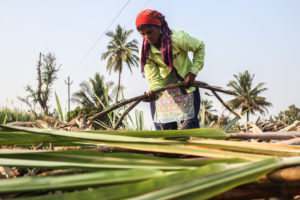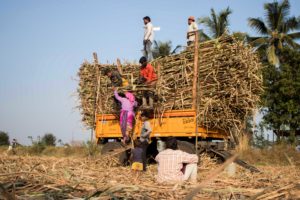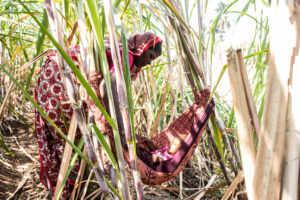By Sanket Jain
Devabai Valvi used to sharpen her sickle every month. That changed when the pandemic swept through India. For the first time, she had to abandon her sickle and watch with dismay as agricultural workers like herself were forced to to be idle. “From March to May (2020), there was no farming work in our village,” she explains. On 23rd March 2020, when India reported 618 COVID cases, India’s Prime Minister, Narendra Modi, hastily declared a lockdown – curbing the movement of 1.3 billion people.
Sixty eight days later, when the lockdown was lifted, India had already registered 189,273 COVID cases, and today, nine months later, it has surpassed 10 million cases and reported over 155,000 deaths. India now has the highest number of COVID cases after the United States.
Wearing a three-layered cotton mask, Devabai did step out of her house in the first week of June to resume farming. But after watching a few healthcare workers arrive in her village to do a survey of Covid 19 victims, she stopped.
“There were rumors that someone in our area had come down with COVID 19,” she remembers. Upon testing, the healthcare workers confirmed that the villager tested positive. This wasn’t the first case in the village of Deogaon, which is located in the Jalgaon district of Western India’s Maharashtra state. However, what followed brought havoc to the lives of 1648 people living in this remote village.

A week’s lockdown further impacted the 35-year-old Devabai, as she lost another seven days of work amounting to $12, which would normally put food on the table. Facing the loss of a whole season’s income, she was forced with her family to migrate a long distance to work as a sugarcane cutter .
The Poverty Quagmire
Devabai’s answer to a health emergency, big or small, is to “take an injection [of painkillers], rest for an hour, and start cutting the sugarcane again.” Medical professionals disapprove of this practice, which doesn’t necessarily treat the problem. But their warnings tend to go unheeded by villagers who desperately need to work to earn money. In cases when Devabai comes down with a serious medical condition, her daughter “doubles up and cuts even my share of the cane.”
Devabai, 35, and her husband, Ganesh, in his early 40s, have cut over 90,000 kilograms (equivalent to 198,000 pounds) of sugarcane with a Koyta (sickle) in four months in their new location in the Kolhapur district of Western India’s Maharashtra state.
“We can’t take a break in this work,” she says.
For several decades, over a million sugarcane cutters, predominantly from lower castes and marginalised communities, have migrated hundreds of miles from their villages in Maharashtra’s drought-prone districts to the sugarcane cultivating districts of Western Maharashtra and Northern Karnataka. They are brought to these regions by contractors, who pay an advance for their work, which starts in October and continues til April. This past year, Devabai and Ganesh joined the swelling numbers of workers swarming to the region during the pandemic.
The Valvis had taken an advance of Rs 40,000 ($548) from the contractor. It roughly translates to cutting over 160,000 kilograms of sugarcane within six months. “If we don’t cut this sugarcane in time, then we’ll have to return next year to make up for lost production. There’s no escape,” Ganesh explains while loading sugarcane in a trailer, 400 miles away from his home.
For a decade now, the Valvis have been trying not to fall into this work, but systemic inequalities trap them. “For six months, we don’t get water in our village. That’s why we migrate,” says Devabai.
A recurring agrarian disaster
Leaving the sugarcane fields in the spring and returning to his village of Deogaon, Ganesh needed another $548 (most of it to buy cotton seeds and fertilizers) to cultivate cotton on his father-in-law’s three-hectare land. “The district co-operative society refused me a (pre-monsoon) crop loan because of the lockdown, and hence I took an advance from the contractor,” he says, realising it would come at a terrible cost. His other option of taking a loan was going to the upper caste moneylenders, known for exploiting the marginalized and charging exorbitant interest rates.
Devabai and Ganesh are Bhil Adivasis (a designated Indigenous community in India’s Constitution). In the drought-prone regions of Maharashtra the entire village except the senior citizens migrates for over six months – working in informal sectors as low-wage workers. In past years, the Valvis somehow were able to stay in the village for six month and survive on the cotton they managed to harvest with rainwater. For the remaining six months, they would migrate to work in informal sectors, and for the past few years they have been working as sugarcane workers.
Erratic rainfall and fluctuating climate conditions in 2019-2020 made it especially difficult for the Valvis as they reported less than half of the expected production of cotton. What made it worse was the lockdown, which closed down procurement centers holding cotton harvested by the farmers. As a result, 3.2 million quintal cotton (the equivalent of 352,739 US tons) remained unsold in May 2020 in the states of Maharashtra and Gujarat. This was because the markets were shut, and even when they opened, there was a cap on the number of vehicles that could reach the market yards or the procurement centers every day. The poor cotton crop production and reduced sales, combined with the lockdown, made working in the village especially precarious for the Valvis due to lost income; for the rest of the year they had to struggle to survive as sugarcane workers.
Inhumane working conditions
Maharashtra remains the second-highest sugar producing state in India with 181 sugar mills – recording a massive production of 51.55 lakh tonnes of sugar (or 5.68 million US tons) until 15th January, 2021 in four months of this season. Traditionally, the sugar mills in Maharashtra functioned as co-operatives with politicians as its board members. Today, the number of private mills is rising in the region.

For cutting, hauling, tying, loading, and transporting 1000 kgs of sugarcane ( over 2,000 pounds) in a trailer or bullock cart, the Valvis are paid a mere Rs 240 (approximately $3). Every day, a couple manages to cut 2000 kgs of sugarcane in 28 hours collectively, often imperiling their health and safety, leading to multiple fractures, broken limbs, deep cuts, and several other injuries.
Ganesh Valvi was forced to teach sugarcane cutting to his children, Karan, 16, Nanu, 14, and Anjali, 13, who collectively manage to cut a ton in a day. Usually, contractors hire a couple for cutting cane, but in several cases, they even team up teenagers and kids. With schools shut for over nine months in several parts of India and families facing a much greater workload. child labour is often the norm. “We had to bring all three children to the canefields,” says Ganesh. As per the Census of 2011 (the new Census has yet to be released) there were 10.1 million children between the age of 6 and 14 working in India of which 80 percent of the child labour remained concentrated in rural areas. As a result of the pandemic, those Census numbers are likely to be much higher.
With no written contracts or government oversight over the contractors, they get away with fining workers as high as $8 per day for skipping the work despite the health emergencies brought on by Covid 19. Karan, who’s in grade 10, says, “I had to learn cutting the cane within three months. I tried studying on the phone, but couldn’t because of this work.” Even if the contractors take the workers to the doctor, they later adjust the payment accordingly.
On any one-hectare sugarcane field assigned to the sugarcane workers, there are people from the age group of 1-70 involved in this task. (Yes, even one-year-olds are brought onto the fields as there is no one to take care of them at home) For 55-year-old Indubai, retirement seems a long way off. She wakes up at 4 am daily, cooks food, walks over four miles to fetch water, takes care of her grandchildren, cuts over 1000 kilograms of sugarcane in a day, carries bundles weighing at least 20 kilograms on her head, and returns to the yellow tarpaulin tents that are “home” to the workers in order to cook food. For two decades now, this has been her routine for six months every year. “There’s no rest,” she says, exhausted, with pain evident in her voice.
Indubai showed me a few uncut sugarcanes and asks me to look at a red-colored hammock-like structure. A nine-month-old infant was sleeping in a saree tied between the two adjoining sugarcane stems. “That’s where it starts,” she says, alluding to the larger humanitarian crisis the sugarcane workers are experiencing.

Several cane cutters I spoke to mentioned the vicious cycle of debt that traps them in this line of work. Ripka Pakhre, 40, had somehow managed to escape it before the pandemic hit. “For three years, we stopped cutting the cane,” she says. However, with no work in the village because of the lockdown, she was forced to work as a sugarcane cutter again.
“As agricultural laborers, for nine hours of work, we only get $1.70 a day in our village. With lockdown, even that work came to an end,” she says. She now fears for her daughter, Laxmi, 17, who has started cutting the cane to help the family make ends meet. At the age of three, Laxmi met with an accident that injured one of her eyes. “The doctor had warned us that she will keep losing her vision as time passes by,” explains her mother. ”Four years ago, the doctor’s words came true and Ripka had to immediately undergo corrective surgery . We spent $685 for the operation in a private hospital, and now she can see properly.”
Before the operation, Laxmi temporarily quit her education – dropping out of grade 8. “Earlier, she had to quit schooling because of the surgery; now there’s this Corona, what is next?” she asks.
Ripka’s troubles began escalating when her son-in-law’s family began forcing her to pitch in money to treat his swollen leg, affected by a poisonous thorn. With no help at public hospitals, which are grossly underfunded and under-resourced, the family had to eventually spend $2740 at a private hospital, sourcing half this amount from the contractor. Ripka knew this would come with multiple problems and that more family members would likely suffer as a result. Her son was already paying the price of rapid privatization of education and dwindling wages. “I had to quit my education in grade 7 and start working,” says 21-year-old Abhiman, mentioning how he couldn’t afford the schooling anymore.
After dropping out of school, Laxmi started accompanying Ripka to the fields. For the first time in her life, she has been forced to work in the sugarcane fields. “Even if I start going to school,” she laments, “I will have to deal with the stigma of having to work instead of getting an education.”
In several parts of rural India, the continuing education of girls is often prevented beyond a primary school education. Twenty miles away in the village of Kolhapur, this burden of patriarchy prevails. Explains Rinkubai More, who has been cutting cane for over a decade now, “I don’t want my children to do this work.” Sexist traditions made one of her worst nightmares come true. Her daughter, Yogita, enrolled in grade six, can’t go to school anymore. “There’s no higher school in the village, and the nearest school is over 12 miles away.” In India, 39.4 percent of girls between the age group 15-18 drop-out.
Rinkubai has taken an advance of $958 from a contractor. Her nine-and-seven-year-old children are also helping her with her work. A few days ago, one of them was injured while cutting the cane, but this same child had to load the trailer at 3.30 p.m. in scorching heat with temperatures climbing to 35 degree Celsius (95 degrees Fahrenheit) even in January.
Bearing the cost of inhumanity
In the last week of December, Sangeeta Dhawale, 35, was devastated by a leg injury. “A heavy, six-foot-long wooden plank fell on my right leg while I was loading the tractor,” she told me. The contractor refused to take her to the doctor and asked her to finish the work first. Yet she managed to get an X-ray done on her own while the contractor was not around for a few hours. For this, Sangeeta used her savings that she brought while migrating to the sugarcane fields. The image showed a major fracture. “I’ve already spent [the US equivalent of] $9 on an X-ray and $5.5 on painkillers,” she explains. Temporarily, Sangeeta has rolled a crepe bandage around her wounded leg until she has enough money to return home in the spring.
Having to wait over 100 days till she can leave for her home in April could be perilous. “The other day, the contractor bluntly told me if they take me to the hospital, then who will cut the sugarcane? I am even willing to somehow repay the entire advance, but I want to go home now,” she says. Sangeeta fears she will run out of money for everyday essentials if she seeks treatment. Accompanying her are her mother-in-law, Sakubai, in her early 60s, who’s been cutting cane for 15 years, and son, Swapnil, 21, who lost his left eyesight almost a decade back. “The contractor won’t let us go home until we cut the cane,” says Swapnil, who fears dropping out from his undergraduate commerce course.
Privatization of education, inadequate healthcare, extreme episodes of agrarian distress –all force the workers to seek loans at exorbitant interest rates, eventually landing them in poverty. Healthcare expenses alone pushed 55 million Indians into poverty in 2011-12, with 38 million of their spending the money on medicines alone.
The Economic Survey of India (2020-21), published in January 2021, states that India has one of the highest out-of-pocket health expenditures (expenses borne directly by the patient) in the world. Over 60 percent of hospitalisation cases in rural India report such expenses.
Sangeeta, whose hopes have been destroyed over the last decade, now awaits the end of April, when workers can return to their villages. “I hope we can cut the leftover sugarcane and find a way to escape this,” she says, her voice disappearing into the thuds of sugarcane cutting.
Sanket Jain is an independent journalist based in the Kolhapur district of Western India. He is also a 2019 People’s Archive of Rural India fellow where he is documenting vanishing art forms from the Indian countryside. He has written for the Baffler, Progressive Magazine, Counterpunch, Byline Times, The National, Popula, Media Co-op, Indian Express and several other publications.
